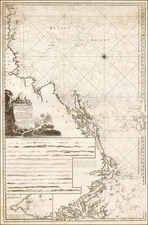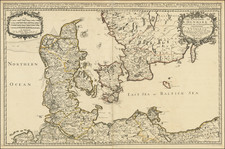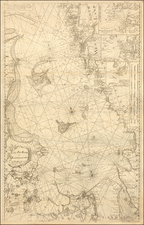Fine 18th Century hand drawn map of the Province of Gotland in Sweden.
Oriented with southeast at the top, The map illustrates early towns, roads, lakes, islands and other details.
At the beginning of the 1700s, Gotland was part of the Swedish Empire, which was a significant power in Northern Europe. The island, with its strategic position in the Baltic Sea, was historically important for trade and had long been a meeting point for merchants from various parts of the continent. Visby, the largest town on Gotland, was a member of the Hanseatic League and had thrived due to this trade network, though by the 18th century, its significance within the League had waned.
The Great Northern War (1700-1721) between Sweden and a coalition of Russia, Denmark-Norway, and Saxony-Poland-Lithuania affected Gotland as the Swedish Empire's territories were contested. Although Gotland was not a central battlefield, the conflict drained resources and attention from the Swedish crown, and the island's defense was neglected. This led to a brief occupation by Russian forces in 1715, which caused a considerable amount of destruction in Visby and the surrounding countryside, contributing to the island's economic challenges.
Following the war, Sweden ceded significant territories, but Gotland remained under Swedish control. The island's economy during the 18th century was predominantly agrarian, with farming and animal husbandry as the mainstays. However, the economic hardship was exacerbated by several poor harvests and a series of devastating fires in Visby throughout the century.
The late 18th century brought some improvement in Gotland's fortunes. The Enlightenment began to influence the island, with new ideas in agriculture and science seeping into local practices, which gradually improved the economic situation. The reconstruction efforts in Visby and the development of better agricultural methods led to a slow recovery towards the end of the century.
Culturally, the 18th century saw Gotland maintain its unique traditions, language, and architecture. The island's relative isolation helped preserve these aspects, even as mainland Sweden underwent significant changes.









![[Swedish Cities] Charta ofwer Upstaden Wadstena No. XLVIII [with] Charta ofwer Upstaden Skeninge No. XLIX.](https://storage.googleapis.com/raremaps/img/small/70095.jpg)
![[Denmark and Southern Sweden] Danorum Marca, vel Cimbricum, aut Daniae Regnum . . . M. D. LXXXV.](https://storage.googleapis.com/raremaps/img/small/91201.jpg)


![[ Elfsborgs Chiefdom, Southwestern Sweden ] Karta öfver Elfsborgs Höfdingedöme. Utgivfven Af Firherre S. G. Hermelin. . . . Författad af Carl G. Forssell. 1808](https://storage.googleapis.com/raremaps/img/small/99084.jpg)
